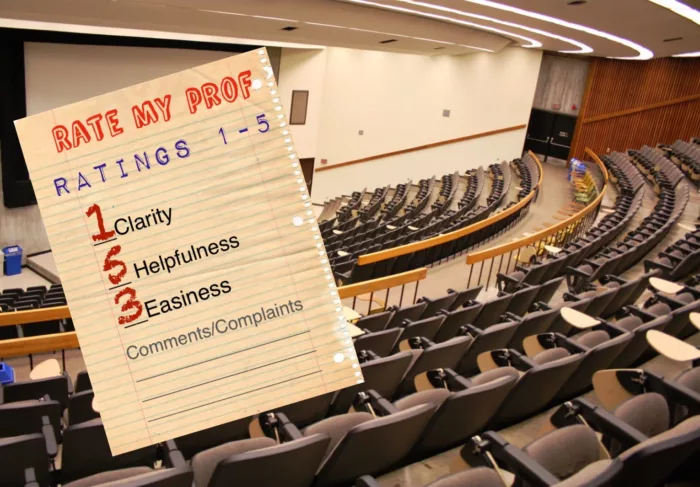Table of Contents
What is RateMyProfessors.Com?
RateMyProfessors.com is an online platform and website that allows students to rate and review college and university professors and courses. It serves as a valuable resource for students seeking information about their potential professors and the classes they may take. The website provides a database of professors from various institutions, and users can search for specific professors or courses to read reviews and view ratings.
RateMyProfessors.com plays a significant role in helping students make informed decisions when selecting courses and professors, as well as in offering professors feedback to improve their teaching methods. It has become one of the most well-known and widely used platforms for professor and course evaluations in higher education.
Professor ratings are crucial for students, offering insights into course quality and aiding class selection. They also provide valuable feedback for educators to enhance their teaching methods.
Online platforms, such as “Rate My Professor,” have transformed professor ratings. They provide dynamic reviews and ratings, empowering students to make informed choices and promoting transparency in education.
Similar read: What is Monday.Com Login
What Are Professor Ratings?

Professor ratings, also known as teacher evaluations or instructor assessments, are systematic assessments of a professor’s performance in a teaching role. These evaluations are typically conducted by students who have completed a course taught by the professor.
The primary purpose of professor ratings is to gather feedback on various aspects of the instructor’s teaching, such as their teaching methods, course content, communication skills, and overall effectiveness in delivering the educational experience.
Similar read: What Is Cinco De Mayo
The History of Professor Ratings
Professor evaluations have been conducted since the early 20th century when educational institutions acknowledged the need to assess teaching quality. Initially, they were paper-based and limited in scope, but over time, standardized forms were introduced. In recent years, online platforms have streamlined the process, making it easier for students to submit ratings and for institutions to analyze the data effectively.
Why Are the Professor Ratings Valuable?
Professor ratings hold several key values in higher education:
Improves Teaching Quality:
Ratings provide valuable feedback to professors, helping them identify their strengths and areas for improvement. This feedback loop encourages instructors to refine their teaching methods and adapt to the needs of their students.
Helps in Informed Decision-Making
For students, professor ratings serve as a resource to make informed decisions when selecting courses and professors. They can gain insights into what to expect in a class and choose instructors whose teaching styles align with their learning preferences.
Ensures Accountability
Ratings promote accountability within educational institutions. When professors are aware that their performance is being assessed, they are more likely to maintain high standards of teaching and invest in their professional development.
Curriculum Enhancement
Institutions can use aggregated data from professor ratings to assess the effectiveness of their curriculum and teaching methods. This information can inform decisions about curriculum changes and faculty development programs.
Increases Transparency
Online platforms have increased the transparency of professor ratings, allowing students to access a wide range of opinions and experiences. This transparency fosters a sense of community among students and encourages them to engage actively in the educational process.
Similar read: What is Blooket/Play
Popular Online Professor Rating Platforms

A. RateMyProfessors.com
Features and Functionality
RateMyProfessors.com is one of the most widely recognized and utilized online platforms for rating and reviewing professors. It offers the following key features and functionalities:
Professor Ratings: Users can search for professors by name or institution and access ratings and reviews provided by fellow students who have taken their courses.
Course Ratings: In addition to professor ratings, students can rate and review specific courses, providing insights into the course content, workload, and overall experience.
User-Generated Content: The platform relies on user-generated content, allowing students to submit ratings and reviews based on their personal experiences with professors and courses.
Categories and Tags: Professors and courses are often tagged with descriptors such as “easy,” “inspirational,” “tough grader,” and more, making it easier for users to find relevant information.
User Experience
RateMyProfessors.com provides a user-friendly experience, with a simple and intuitive interface. Users can quickly search for professors and courses, read reviews, and view overall ratings. The platform’s design encourages students to contribute their reviews and ratings, fostering a sense of community engagement.
Pros and Cons
Pros:
Comprehensive Information: RateMyProfessors.com offers a wealth of information about professors and courses, including ratings, reviews, and specific details about individual instructors.
User-Generated: It relies on user-generated content, ensuring that the information is current and reflective of student experiences.
Helpful Tags: The use of descriptive tags and categories makes it easy for students to identify professors and courses that align with their preferences.
Cons:
Subjectivity: Reviews are subjective and based on individual experiences, which can vary widely. What one student finds valuable in a professor, another may not.
Limited Data Control: Professors have limited control over the information and ratings posted about them, which can lead to concerns about fairness and accuracy.
Similar read: What Is ILGMS Portal
Other Notable Platforms

Ratemyteacher.com:
While primarily focused on K-12 educators, Ratemyteacher.com allows students to rate and review their teachers, offering a similar user-generated experience.
Koofers:
Koofers provides a variety of educational resources, including professor and course ratings. It also offers study materials and practice exams, enhancing the overall student experience.
CampusDirt:
CampusDirt is known for its anonymous posting of campus-related content, including professor ratings and comments. It provides a platform for students to share candid feedback.
Different rating platforms may have varying levels of popularity and user engagement depending on the institution and region. Students often use multiple platforms to cross-reference information and gain a more holistic view of professors and courses.
How to Use RateMyProfessor Effectively?

A. Creating an Account
To effectively use RateMyProfessors.com, you can start by creating a user account. While an account is not always required for basic usage, having one allows you to participate more actively on the platform by submitting your reviews and interacting with other users.
B. Searching for Professors
Search by Name: Use the search bar to look up a specific professor by name. This is the quickest way to find information about a particular instructor.
Search by Institution: If you’re interested in professors at a specific school, you can search by institution to see a list of all professors at that school.
C. Reading and Understanding Reviews
Overall Rating: Pay attention to the overall rating assigned to a professor, typically on a scale from 1 to 5. This gives you a quick snapshot of their perceived quality.
Read Multiple Reviews: Don’t rely solely on one review. Read multiple reviews to get a more comprehensive understanding of the professor’s strengths and weaknesses.
Consider Specifics: Look for specific comments about the professor’s teaching style, grading criteria, workload, and other factors that matter to you as a student.
Check for Consistency: Note if multiple reviews mention the same positive or negative aspects of a professor. Consistency in feedback can indicate reliable information.
D. Submitting Your Examination
If you’ve taken a course with a professor and want to contribute to RateMyProfessors.com, follow these steps when submitting your review:
Log In: If you have an account, log in. If not, consider creating one for a more personalized experience.
Search for the Professor: Find the professor’s page by searching their name or browsing your institution’s page.
Submit a Review: Look for the option to “Submit a Review” or similar wording on the professor’s page. Click on it to start the review process.
Provide Detailed Feedback: Be honest and specific in your review. Include information about the professor’s teaching style, communication, grading, and any advice you have for future students.
Rate the Professor: Assign an overall rating, and if applicable, rate other aspects like easiness, helpfulness, and clarity.
Submit: Review your submission for accuracy, and then submit it. Your review will typically go through a moderation process before being published.
Similar read: What Is Samagra Portal And How Does It Work?
Tips for Accurate Ratings

To ensure your ratings are accurate and helpful to others:
- Be Objective: Base your review on your actual experiences and avoid personal biases.
- Include Context: Provide context for your comments. What might be challenging for one student could be beneficial for another, so explain your perspective.
- Avoid Revenge Reviews: Don’t write a review out of anger or frustration. Be constructive in your criticism.
- Update Reviews: If your opinion changes or if you take multiple courses with the same professor, consider updating your review to reflect your evolving perspective.
- Respect Anonymity: While reviews are typically anonymous, avoid disclosing personally identifiable information about the professor or yourself.
Similar read: A Complete Guide To PFMS Account
Conclusion:
RateMyProfessor has become an invaluable tool for students navigating the complex landscape of higher education. These platforms offer a wealth of information, allowing students to make informed choices about their courses and professors.
- What is Epic Games Launcher and How to Install It? - July 15, 2024
- What Is Audius Music Streaming App and How Does it Work? - July 13, 2024
- The 10 Best Astronomy Apps for Stargazing - July 12, 2024

